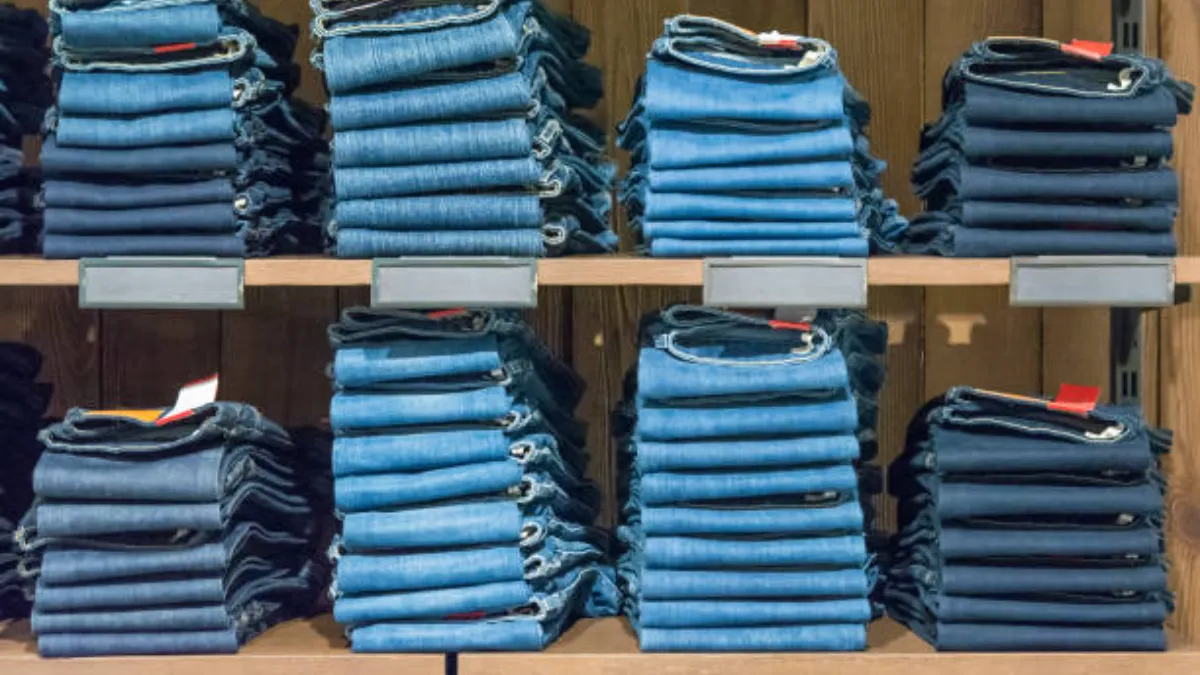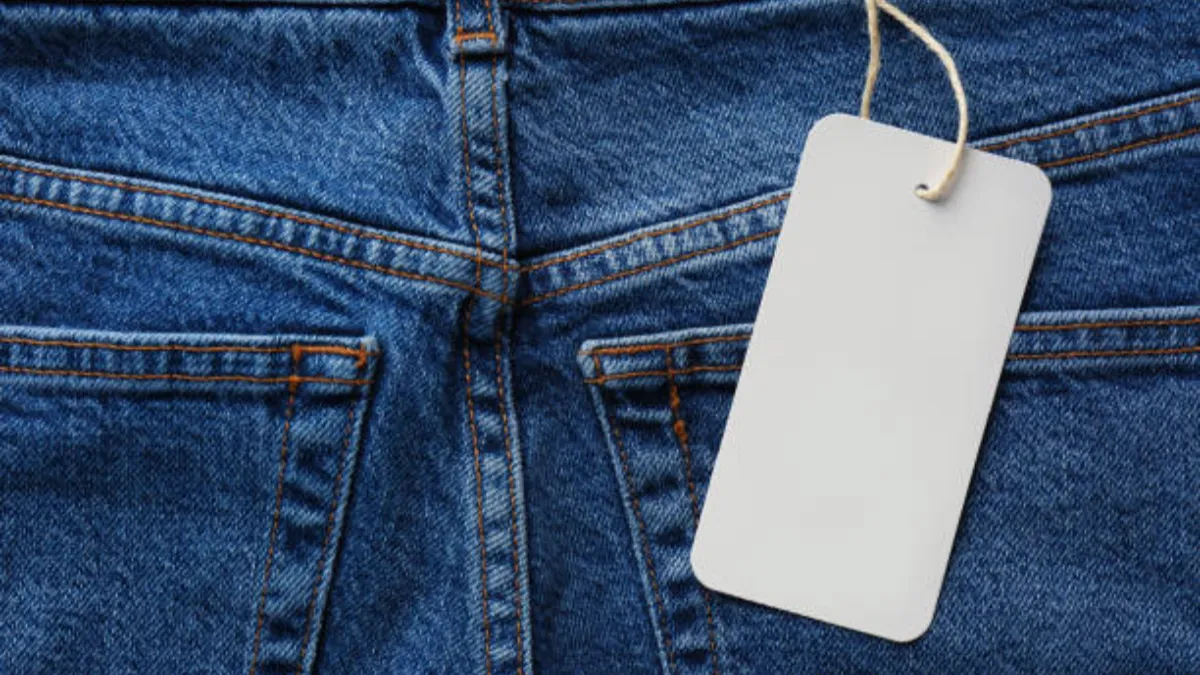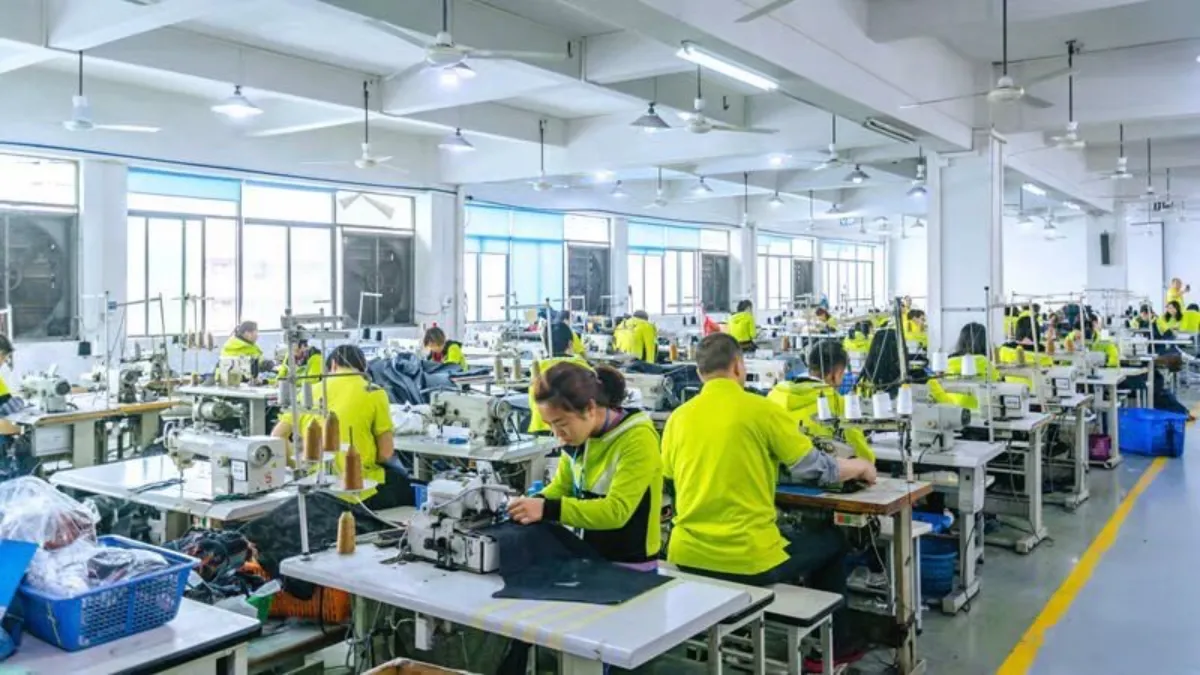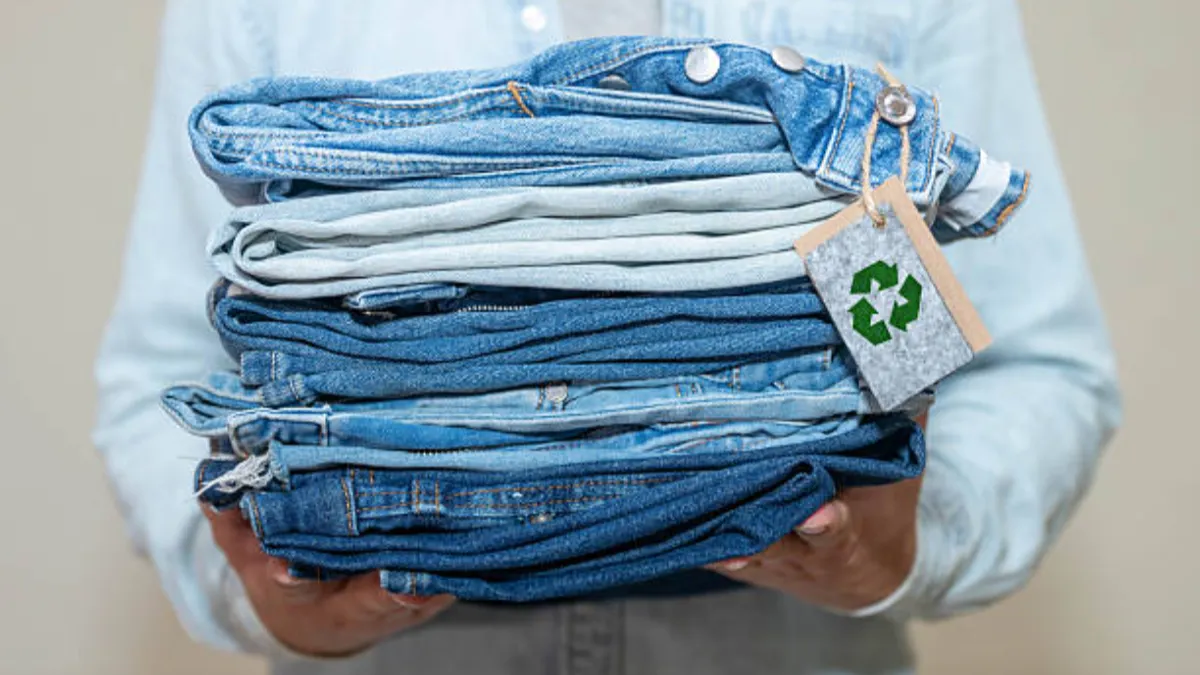Denim and jeans are often used as if they mean the same thing, but many people don’t really know the difference. Simply put, denim is the fabric, a strong cotton textile, while jeans are pants made from that fabric.
This article will clear up the confusion by explaining differences between denim and jeans, different types of denim, and how to care for them. Let’s dive in and explore these important details together.
デニムとは?

Denim is a type of fabric, not a garment and is not all considered as jeans. It is a durable cotton twill textile, characterized by a unique weaving pattern where the weft (crosswise threads) passes under two or more warp (lengthwise) threads. This weaving technique gives denim its distinctive diagonal ribbing, which you can feel if you run your hand across the fabric.
Traditionally, デニムはから作られています 100% コットン, but modern production often blends cotton with elastane or polyester to improve stretch and comfort. The typical weight of denim fabric varies from 8 oz to 14 オンス/平方ヤード, depending on the intended use. 例えば, heavier denim (12 オンス以上) is common in rugged workwear, while lighter denim suits casual, soft jeans.
デニム originated in the late 17th or early 18th century in Nîmes, France, from a fabric called “serge de Nîmes”. It was initially used for durable work clothes. 今日, denim is a global staple, used in various garments beyond jeans, such as jackets, スカート, とシャツ.
What Are Jeans?
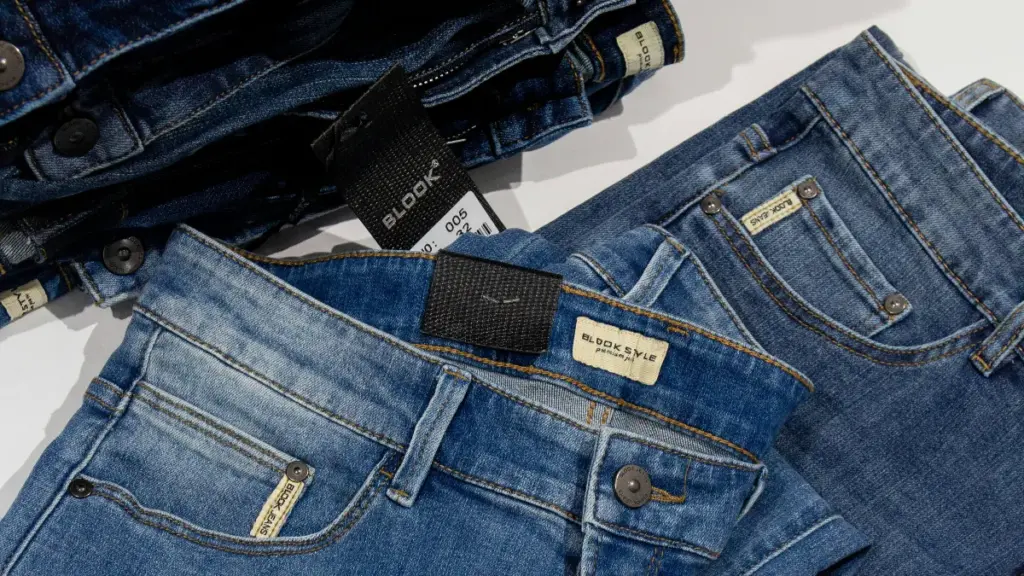
ジーンズ are a specific type of pants made primarily from denim fabric. They are easily recognizable by their classic design features: five pockets (including the small coin pocket), reinforced rivets at stress points, belt loops, and a zipper or button fly. Jeans come in many styles such as straight-leg, skinny, ブーツカット, relaxed fit, などなど.
The history of jeans dates back to the mid-19th century during the American Gold Rush. で 1873, a Bavarian immigrant named Levi Strauss partnered with tailor Jacob Davis to patent the first pair of riveted denim pants. They designed these pants to withstand hard labor, using heavy-duty denim and metal rivets to reinforce areas prone to tearing. This invention laid the foundation for modern jeans and quickly became popular among miners, workers, and eventually the broader public.
How Are Jeあるns Mあるde?
The manufacturing of jeans follows several key stages that determine their durability, 快適, and signature look.
1. Fabric Preparation
High-quality denim is woven using dyed warp yarns and undyed weft yarns. The warp threads are dyed with indigo in multiple dips to achieve the desired depth of color, while the weft threads remain in their natural cotton shade, creating denim’s distinctive blue-and-white structure.
2. Cutting and Sewing
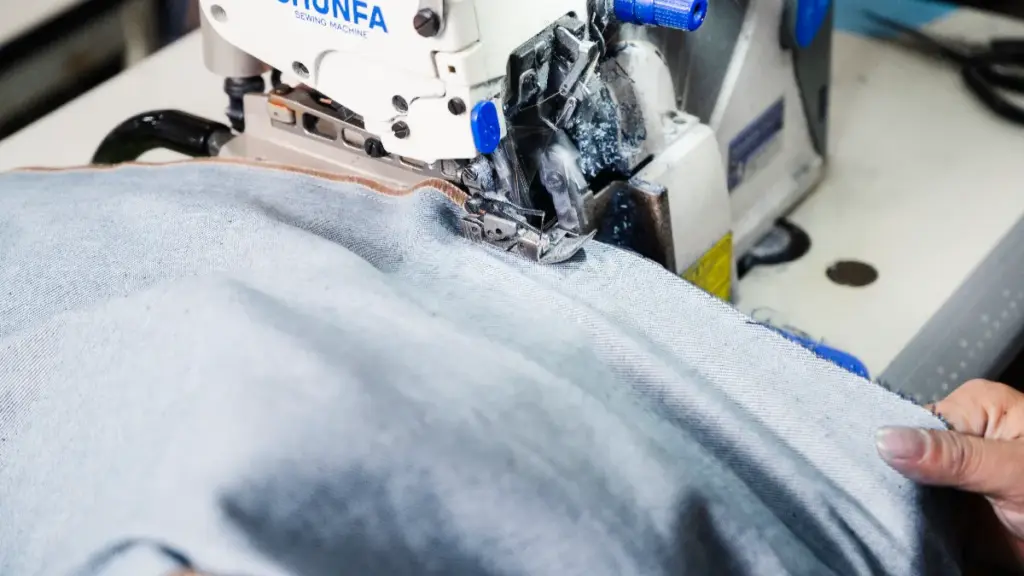
Denim fabric is spread in multiple layers and precisely cut into pattern pieces using industrial cutting machines. These pieces are then sewn together with heavy-duty stitching, including reinforced seams, bar tacks, and rivets at stress points for extra strength.
3. Washing and Finishing

The assembled jeans undergo specialized washing processes such as stone washing, 酵素洗浄, or bleaching to achieve specific textures and shades. This stage can also include whiskering, fading, or distressing for a worn-in appearance.
4. Quality Control and Packaging
Each pair is inspected for consistency in stitching, フィット, and finish. Only products that meet quality standards are pressed, tagged, and packed for shipment.
Popular Types of Denim Used in Jeans Manufacturing
Not all denim is created equal. Different types of denim serve different styles, qualities, and price points. Here are the most popular varieties:
1. 生デニム (Dry Denim)
Raw denim is untreated and unwashed after dyeing. It is stiff, 暗い, and known for developing personalized wear patterns over time. Raw denim jeans are favored by denim enthusiasts for their durability and unique fading. Typically, raw denim weighs between 12 に 16 オズ, making it thicker and more durable.
2. セルベッジデニム
耳 (or selvage) denim is woven on traditional shuttle looms, creating a tightly woven band on each edge that prevents unraveling. This fabric is often considered premium due to its tight weave and craftsmanship. Selvedge denim is recognizable by the colored edge stitching visible when cuffs are rolled. It often weighs 12-14 oz and commands higher prices.
3. ストレッチデニム
To improve comfort and fit, manufacturers blend cotton with elastane (いつもの 1-3%). Stretch denim offers flexibility and better movement, making it popular for skinny and slim-fit jeans. Although lighter (8-11 オズ), stretch denim maintains durability through advanced fabric technology.
4. Colored and Printed Denim
While traditional denim is indigo dyed, manufacturers now use various dyeing and printing techniques to produce colored or patterned denim. These are often used in fashion-forward collections but may decreased durability compared to traditional indigo denim.
5. Lightweight Denim
Weighing below 10 オズ, lightweight denim is softer and used in warm climates or fashion pieces like shirts and dresses. It offers less durability but improved breathability.
Care Tips for Denim and Jeans to Extend Their Lifespan

Proper care is essential for preserving denim quality and the look of jeans. Here are some professional tips:
- Wash Sparingly: Frequent washing can fade denim and weaken fibers. It’s best to wash jeans every 5-10 wears unless stained.
- Cold Water Wash: Use cold water to reduce color bleeding and shrinkage.
- Inside Out: Turning jeans inside out helps protect the dye and reduces abrasion during washing.
- 風乾: Avoid dryers that can shrink or damage denim. Hang jeans to dry naturally.
- Spot Clean: For minor stains, spot cleaning with mild detergent prolongs fabric life.
- Avoid Harsh Chemicals: Bleach and strong detergents degrade fibers and cause color loss.
Sustainability in Denim and Jeans Production
Sustainability is a hot topic in denim manufacturing today. Traditional denim production consumes large amounts of water, エネルギー, 化学物質と. 例えば, producing a single pair of conventional jeans can use up to 7,000 liters of water—roughly the amount a person drinks in seven years.
To address this, many manufacturers are adopting eco-friendly methods such as:
- Organic Cotton: Grown without synthetic pesticides or fertilizers, reducing environmental impact.
- Waterless Dyeing: Techniques like foam dyeing or using ozone to reduce water usage by up to 90%.
- リサイクルデニム: Incorporating recycled cotton fibers from old jeans into new fabric.
- Laser and Enzyme Finishing: Modern finishing methods that reduce chemical use and waste.
Sustainability not only helps the environment but also aligns with consumer demand. Many buyers and end consumers now prefer jeans with transparent, eco-conscious production.
Choosing the Right Denim or Jeans for Your Style and Needs
Selecting the perfect denim or jeans depends on your purpose and preferences. Here are key points to consider:
- 重さ: 厚手のデニム (12 オンス以上) is durable but stiffer, ideal for rugged use. Lighter denim suits casual wear and comfort.
- フィット: Skinny, スリム, 真っ直ぐ, ブーツカット, and relaxed fits serve different body shapes and style goals.
- Stretch: Stretch denim is great for comfort and flexibility but may fade faster than 100% コットンデニム.
- Color and Wash: Dark indigo offers a classic look, while faded or distressed styles are trendy.
- 持続可能性: Increasingly important, consider if the fabric uses organic cotton or eco-friendly processes.
Related Comparisons
What Is the Difference Between Jeans and Pants?
Jeans are a specific type of pants made traditionally from denim and designed with specific features like rivets and five-pocket styling. Pants, however, refer to any type of trouser made from various fabrics such as cotton, wool, ポリエステル, or blends. While all jeans are pants, not all pants are jeans.
What Is the Difference Between Slacks and Pants?
Slacks usually denote dressier trousers made from finer fabrics like wool blends or synthetic fibers. They have a tailored fit and are intended for formal or business settings. Pants is a broader term that includes slacks, ジーンズ, chinos, and other styles.
If you need further detailed insights or specific technical advice about denim jeans production, feel free to reach out. As a seasoned denim jeans manufacturer, I understand the challenges and opportunities firsthand, and I am here to help you navigate this exciting industry.


